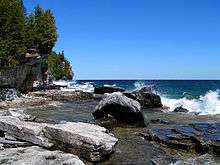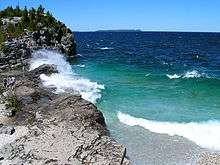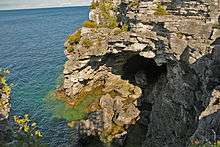Bruce Peninsula National Park
Understand
Near Tobermory, the park covers 154 km2 (59 sq mi), a little smaller than Liechtenstein. It was established in 1987.
The park is one of the largest protected areas in southern Ontario, forming the core of UNESCO's Niagara Escarpment World Biosphere Reserve.
- Park office, ☎ +1 519-596-2233, toll-free: +1-888-773-8888, e-mail: bruce-fathomfive@pc.gc.ca.
Geology
The Niagara Escarpment runs from Rochester (New York), to Tobermory, then on to Manitoulin, St. Joseph Island and other islands located in northern Lake Huron where it turns westwards into the Upper Peninsula of northern Michigan, south of Sault Ste. Marie. The escarpment then extends southwards into Wisconsin following the Door Peninsula and then more inland from the western coast of Lake Michigan and Milwaukee ending northwest of Chicago near the Wisconsin-Illinois border. It forms the backbone of the Bruce Peninsula and shapes the northern boundary of most of the park and provides the park with some of its most spectacular scenery.
The rock of the escarpment is very old. Approximately 400 million years ago, this area was covered by a shallow tropical sea teeming with life in the form of plant-like animals, crustaceans, living corals and mollusks. It would have looked much like the present-day Great Barrier Reef of Australia. When the sea began to dry up, the minerals dissolved in it became more and more concentrated. Magnesium in the water was absorbed into the limestone, which then became a harder, slightly different sort of rock, called dolostone.
The harder dolostone forms much of the rock of the escarpment cliffs along Bruce Peninsula National Park's Georgian Bay shoreline. At Niagara Falls, the dolostone "caprock" is more resistant to erosion than the rock below it, creating the sculptured cliffs for which the area is famous. Since the last Ice Age, water levels in the region have undergone great changes. Softer limestone has been eroded away by water action, leaving magnificent overhanging cliffs at various points along the shore. These are the big attraction of the Cyprus Lake trails. Where erosion has cut more deeply, caves have been formed, such as the famed "Grotto" on the shore between the Marr Lake and Georgian Bay Trails. Great blocks of dolomite, undercut by wave action, have tumbled from the cliffs above and can be clearly seen below the surface of the deep, clean waters of Georgian Bay.
Visitors' centre
A visitors' centre serves Fathom Five National Marine Park and the Bruce Peninsula National Park. It features an information centre, reception area, exhibit hall and theatre. A 20-metre viewing tower provides visitors with aerial views of the surrounding park and Georgian Bay.



History
Landscape
Flora and fauna
Animals that inhabit this national park are chipmunks, squirrels, red foxes, raccoons, coyotes, black bears, porcupines, snowshoe hares, skunks, white-tailed deer, snakes and frogs.
Climate
The park has a maritime climate with cool summers and mild winters. In the northern parts of the Peninsula, the climate is among the most temperate in Canada. The climate of park is influenced by Georgian Bay and Lake Huron, which significantly moderate temperatures. As a result, they tend to prolong milder temperatures in the fall and cooler temperatures in spring. Summers are warm, with an average temperature of 16.8 °C (62.2 °F) while winters are cool, averaging −6.7 °C (19.9 °F). Summers are dominated by hot, humid air masses from the Pacific Ocean and the Gulf of Mexico. In winter, Pacific air masses predominate, bringing in warm and humid air although cold, dry air from the Arctic highs can occur, bringing in colder and drier conditions. Warm air masses coming from the Gulf of Mexico are rare during winter but are responsible for bringing January and February thaws. Spring and fall are characterized by complex weather patterns with contrasting and rapidly changing influences from the different regional air masses. The park receives 900 mm (35 in) of precipitation per year. This is evenly distributed throughout the year with fall (September–November) being the wettest. Precipitation is slightly lower than inland areas due to the limited influence that the narrow peninsula has when air masses travel over it compared to more interior locations.
Get in
The park is accessible from the south along Highway 6, or from the north via Owen Sound Transportation Company's ferry, the MS Chi-Cheemaun, which operates during the spring, summer and fall.
Fees and permits
Parking, daily (2018):
- per vehicle $11.70
- per bus $49.00
Parking, seasonal
- per vehicle $49.00
- per bus $132.40
Parks Canada Passes
The Discovery Pass provides unlimited admission for a full year at over 80 Parks Canada places that typically charge a daily entrance fee It provides faster entry and is valid for 12 months from date of purchase. Prices for 2018 (taxes included):
- Family/group (up to 7 people in a vehicle): $136.40
- Children and youth (0-17): free
- Adult (18-64): $67.70
- Senior (65+): $57.90
The Cultural Access Pass: people who have received their Canadian citizenship in the past year can qualify for free entry to some sites.
Get around
See
- Bruce Peninsula National Park also offers visitors vistas to view either the sunrise or sunset, the rocks of the Niagara Escarpment, and the wildlife, which includes black bear, many species of birds, wild orchids, and Massasauga Rattlesnake.
- The visitors' centre in the town of Tobermory can help provide timely and important information; May-Jun and Sep-Oct: daily 9AM-5PM; Jul-Aug: daily 8AM-8PM. The centre features:
- exhibits for all ages including the "Fathom Five 3D" exhibit.
- An accessible 100-seat theatre with hourly presentations of the park's feature film, Life on the Edge.
- A 65 ft (20 m) lookout tower and nearby trails providing water access and views of Georgian Bay.
- Interpretive programs for all ages and special events throughout the summer season.
Do
The park has trails ranging in difficulty from easy to expert, and connects to the Bruce Trail. activities
- Animal and bird watching
- Mountain climbing
- Hiking
- Snowshoeing
- Swimming
- Camping
- Cross country skiing
- Fishing
- Interpretive trail
- Motorboating
- Picnicking
- Beaches
- Canoeing
- Cycling
- Geocaching
- Kayaking
- Mountain biking
- Paddling
- Scuba diving
Buy
Eat
Drink
Sleep
Lodging
Yurt camping at Cyprus Lake is very popular: reservations are required for the 10 yurts available along the shore of Cyprus Lake.
Reservations can be made on-line at www.reservation.pc.gc.ca or by calling +1-877-RESERVE (+1-877-737-3783). Yurts are closed during the winter.
The yurts are 6 m (20 ft) in diameter and are furnished with a woodstove, beds, large deck and propane BBQ. Each yurt has a locking door.
Camping
Camping is available throughout the year at the Tamarack area of Cyprus Lake Campground and at the backcountry locations of Stormhaven and High Dump. Camping for all locations is first-come, first-served.
All campers must self-register at the kiosk at P2 at Cyprus Lake. Please bring exact change.
Potable water is not available. Bring your own water, or purifying system. Or you can boil your water before use. Do not bring your own firewood. Wood is available at Cyprus Lake Campground only.
Fires are only allowed in designated fire pits in the Cyprus Lake Campground. Fires are not allowed in other areas, including the High Dump and Stormhaven backcountry campsites.
Toilet facilities are pit privies. There are no flush toilets or running water in any of the campgrounds during winter. Please pack out all garbage.
Fees (2018):
Group camping:
- One night without showers, per person $4.90
- Reservation fee per reservation $9.80
Cyprus Lake
- One night unserviced with washroom building having toilets only $23.50
- Additional vehicle, per night $11.70
- Winter camping, per site (mid-October to mid-April) $15.70
Backcountry
Backcountry use and camping:
- One night overnight, per person $9.80
Stay safe
- Weather Radio at 90.7FM provides daily weather updates.
